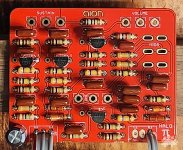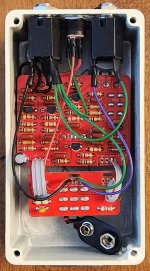Fingolfen
Well-known member
- Build Rating
- 5.00 star(s)
For this build I went back to where it all started for me in terms of Big Muff builds, the '73 David Gilmour Ram's Head, which is one of many versions included on the AionFX spreadsheet and detailed on Kit Ray's BMP page. I wanted to go with the David Gilmour version because I'm currently working on learning the outro solo to Pink Floyd's "Comfortably Numb" (wish me luck - I'm gonna need it), and I really wanted a good Big Muff pedal to help me capture his sound as closely as possible (without spending tens of thousands of dollars on gear!). On my previous builds, I had used carbon composition resistors (Allen Bradley) like the originals, but for this one I decided to use carbon film instead to see if I could get a lower noise floor. All of the resistors are 5% Yageo carbon film, including the CLR for the LED.

In addition to testing the noise floor, I also wanted to experiment a little with the transistors. There are a lot of different schools of thought, but there is data to suggest that the transistors on the early BMP circuits were fairly low gain compared to some of the later units. For this build, I went with PN5133 transistors (which I used in my Violet Ram's Head 2 build about a year ago). I also went one step further checking the gain on all four before I committed to the build - the gain measured roughly 125 to 165 for the four, which is similar to values reported for some early Big Muff circuits.

For the capacitors, I've gone with all metal film capacitors. Most of them are NOS Panasonic - even in the variable mids stage enabled by the "Mids" switch on the AionFX PCB. There are a few more modern replacements (Topmay) where I couldn't get the Panasonic equivalent. I'm also using a few of my very last 1N4148 NOS diodes. I'd gotten these from Pedalhacker in ages past (along with the transistors), and I think I ultimately bought him out as these have been out of stock for months. There is one electrolytic capacitor and one 100nF MLCC (the power supply filter capacitors) that are both new production (Nichicon and Vishay if memory serves).
My BMP builds are one of the few that I include the option of a battery, though I seldom use it myself. I'm using switchcraft jacks (one mono, one stereo to accommodate the wiring for the battery). Per normal AionFX design, the pedal uses a star ground to the input jack. All of the wiring connections to the jacks are insulated with heat shrink tubing.

As you can see from the enclosure art, it is very similar to the standard 3-knob version I detailed last year. The coloring on the dinosaur is a little different as is the final shading. I'm also going with different knobs on this version for the time being. I went with a purple LED for the "Violet" Ram's Head connection, and it makes it stand out nicely on the board.
In terms of the sound, there is still a noise floor, but it is not as pronounced as some of my other builds. It is easily cleaned up with a noise gate, and if you adjust your guitar's volume in combination with the rest of your pedal train, the slight hiss completely disappears. In terms of the sound of the effect, it absolutely nails the BMP sound I was going for with this pedal, and honestly I think this one is going to find at least a semi-permanent home on my pedal board.
Tiny bit more at the blog: https://steggostudios.blogspot.com/2023/03/its-bmp-time-again-73-gilmour-rams-head.html

In addition to testing the noise floor, I also wanted to experiment a little with the transistors. There are a lot of different schools of thought, but there is data to suggest that the transistors on the early BMP circuits were fairly low gain compared to some of the later units. For this build, I went with PN5133 transistors (which I used in my Violet Ram's Head 2 build about a year ago). I also went one step further checking the gain on all four before I committed to the build - the gain measured roughly 125 to 165 for the four, which is similar to values reported for some early Big Muff circuits.

For the capacitors, I've gone with all metal film capacitors. Most of them are NOS Panasonic - even in the variable mids stage enabled by the "Mids" switch on the AionFX PCB. There are a few more modern replacements (Topmay) where I couldn't get the Panasonic equivalent. I'm also using a few of my very last 1N4148 NOS diodes. I'd gotten these from Pedalhacker in ages past (along with the transistors), and I think I ultimately bought him out as these have been out of stock for months. There is one electrolytic capacitor and one 100nF MLCC (the power supply filter capacitors) that are both new production (Nichicon and Vishay if memory serves).
My BMP builds are one of the few that I include the option of a battery, though I seldom use it myself. I'm using switchcraft jacks (one mono, one stereo to accommodate the wiring for the battery). Per normal AionFX design, the pedal uses a star ground to the input jack. All of the wiring connections to the jacks are insulated with heat shrink tubing.

As you can see from the enclosure art, it is very similar to the standard 3-knob version I detailed last year. The coloring on the dinosaur is a little different as is the final shading. I'm also going with different knobs on this version for the time being. I went with a purple LED for the "Violet" Ram's Head connection, and it makes it stand out nicely on the board.
In terms of the sound, there is still a noise floor, but it is not as pronounced as some of my other builds. It is easily cleaned up with a noise gate, and if you adjust your guitar's volume in combination with the rest of your pedal train, the slight hiss completely disappears. In terms of the sound of the effect, it absolutely nails the BMP sound I was going for with this pedal, and honestly I think this one is going to find at least a semi-permanent home on my pedal board.
Tiny bit more at the blog: https://steggostudios.blogspot.com/2023/03/its-bmp-time-again-73-gilmour-rams-head.html

